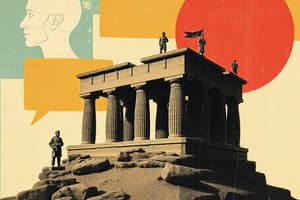Podcast
Questions and Answers
What geographical region is referred to as the cradle of civilization?
What geographical region is referred to as the cradle of civilization?
- The Fertile Crescent (correct)
- The Nile Valley
- The Indus Valley
- The Sahara Desert
Which rivers are primarily associated with the development of Mesopotamian civilization?
Which rivers are primarily associated with the development of Mesopotamian civilization?
- Yangtze and Ganges
- Mississippi and Missouri
- Tigris and Euphrates (correct)
- Nile and Amazon
Who were the rulers of the Sumerian cities during their civilization?
Who were the rulers of the Sumerian cities during their civilization?
- Warrior kings
- Priest kings (correct)
- Merchant leaders
- Elected officials
What was a significant writing system developed by the Sumerians?
What was a significant writing system developed by the Sumerians?
Which technological advancement was NOT created by the Sumerians?
Which technological advancement was NOT created by the Sumerians?
What is the name of the important epic recorded by the Sumerians?
What is the name of the important epic recorded by the Sumerians?
Which social class was NOT part of the Sumerian societal structure?
Which social class was NOT part of the Sumerian societal structure?
Which of the following is NOT considered evidence of Sumerian civilization development?
Which of the following is NOT considered evidence of Sumerian civilization development?
What was the primary basis for the appointment of government officials in ancient China?
What was the primary basis for the appointment of government officials in ancient China?
Which crop was NOT mentioned as a staple in ancient Chinese agriculture?
Which crop was NOT mentioned as a staple in ancient Chinese agriculture?
What invention is NOT attributed to ancient Chinese civilization?
What invention is NOT attributed to ancient Chinese civilization?
What was the backbone of the Chinese economy during ancient times?
What was the backbone of the Chinese economy during ancient times?
Which of the following best describes the taxation system in ancient China?
Which of the following best describes the taxation system in ancient China?
Which philosophical systems influenced early Chinese religion?
Which philosophical systems influenced early Chinese religion?
What major factor contributed to China's development mentioned in the content?
What major factor contributed to China's development mentioned in the content?
What term describes the divine right to rule associated with the dynasties in ancient China?
What term describes the divine right to rule associated with the dynasties in ancient China?
What does the term 'Mesopotamia' mean?
What does the term 'Mesopotamia' mean?
Which of the following was a major deity in Mesopotamian religion?
Which of the following was a major deity in Mesopotamian religion?
What was the significance of ziggurats in Mesopotamian society?
What was the significance of ziggurats in Mesopotamian society?
What was a major consequence of Mesopotamia's limited natural resources?
What was a major consequence of Mesopotamia's limited natural resources?
How did religion influence governance in Mesopotamia?
How did religion influence governance in Mesopotamia?
What area is known as the Fertile Crescent?
What area is known as the Fertile Crescent?
Which of these gods was associated with wind in Mesopotamian belief?
Which of these gods was associated with wind in Mesopotamian belief?
What role did priests play in Mesopotamian society?
What role did priests play in Mesopotamian society?
What type of governance structure is suggested for the Indus Valley Civilization?
What type of governance structure is suggested for the Indus Valley Civilization?
What was a primary focus of the polytheistic beliefs in the Indus Valley Civilization?
What was a primary focus of the polytheistic beliefs in the Indus Valley Civilization?
Which of the following advancements was NOT associated with the Indus Valley Civilization?
Which of the following advancements was NOT associated with the Indus Valley Civilization?
What economic system did the Indus Valley Civilization primarily use?
What economic system did the Indus Valley Civilization primarily use?
Which river is associated with the Shang Civilization?
Which river is associated with the Shang Civilization?
What is the significance of the annual flooding of the Huang Ho River?
What is the significance of the annual flooding of the Huang Ho River?
Which of the following cultures existed before the Shang Civilization?
Which of the following cultures existed before the Shang Civilization?
What was the main activity during the time of the Yangshao culture?
What was the main activity during the time of the Yangshao culture?
What was one of the primary uses of the cuneiform writing system developed by the Mesopotamians?
What was one of the primary uses of the cuneiform writing system developed by the Mesopotamians?
Which legal document is recognized as one of the oldest in history from Mesopotamia?
Which legal document is recognized as one of the oldest in history from Mesopotamia?
What term describes the independent governments of early Mesopotamian civilizations?
What term describes the independent governments of early Mesopotamian civilizations?
What agricultural technique did the Mesopotamians use to enhance crop production?
What agricultural technique did the Mesopotamians use to enhance crop production?
What was the primary economic system used in Mesopotamia before currency became common?
What was the primary economic system used in Mesopotamia before currency became common?
What does the term 'lugal' mean in the context of Mesopotamian city-states?
What does the term 'lugal' mean in the context of Mesopotamian city-states?
What was a major consequence of the unification of individual city-states in Mesopotamia?
What was a major consequence of the unification of individual city-states in Mesopotamia?
Which resource scarcity led to Mesopotamians engaging in long-distance trade?
Which resource scarcity led to Mesopotamians engaging in long-distance trade?
Flashcards are hidden until you start studying
Study Notes
Mesopotamian Civilization
- Geography: Mesopotamia, known as the "land between the rivers," was located between the Tigris and Euphrates rivers.
- Fertile Crescent: The region was part of the Fertile Crescent, known for its rich agriculture.
- Natural Resources: Mesopotamia had limited natural resources, like stone, timber, and metals, leading to extensive trade.
- Religion:
- Mesopotamians were polytheistic, worshiping numerous gods associated with natural forces and daily life.
- Major deities included Anu (sky god), Enlil (god of wind), Ishtar (goddess of love and war), and Marduk (patron god of Babylon).
- Ziggurats were monumental temple complexes built to honor their deities.
- Religion played a significant role in governance and daily life; priests held substantial power, and kings often claimed divine right to rule.
- Achievements:
- Cuneiform: The earliest known writing system, used for record-keeping, literature (like the Epic of Gilgamesh), and legal documents.
- Code of Hammurabi: A comprehensive set of laws based on social justice, crime, and punishment, one of the oldest in history.
- Political Structure:
- City-States and Kingship: Independent city-states, each with its own government, ruler, and deities, functioning as small nations.
- Empires and Centralization: Over time, city-states were conquered and unified into larger empires, centralizing power.
- Economy:
- Agriculture: A crucial aspect of Mesopotamian life, focused on wheat and barley cultivation.
- Irrigation: Improved agricultural productivity.
- Trade: Due to resource scarcity, Mesopotamians engaged in long-distance trade with neighboring civilizations, exchanging crops, textiles, and crafted goods.
- Barter System: As the primary economic system.
Chinese Civilization
- Geography: The Huang Ho (Yellow River) was a critical component of the Shang Civilization.
- Fertile Soil: The river's floods deposited loess (yellow soil), acting as fertilizer for agriculture.
- River of Sorrow: The river's annual flooding caused significant loss of life.
- Early Settlements: Before the Shang, cultures like Yangshao (3000-1500 BCE) and Lungshan (2500-2000 BCE) emerged, with sewing as a major activity.
- Government: Merit-based appointments of officials, often determined by Confucian knowledge and civil service examinations.
- Military: Powerful military forces were maintained to defend borders.
- Economy:
- Agriculture: The backbone, with crops such as millet, rice, and wheat.
- Silk Production: China was a pioneer in silk production, playing a significant role in the economy.
- Taxation and State control: The government held tight control over the economy, often collecting taxes in grain or labor.
- G.R.A.P.E. Summary:
- Geography: China's development was influenced by its fertile river valleys, isolated location, and abundance of resources.
- Religion: Centered around ancestor worship, nature gods, and later Confucianism and Daoism.
- Achievements: Paper, the compass, silk production, gunpowder, urban planning, and writing advancements.
- Politics: Ruled by dynasties employing a centralized bureaucratic system, the Mandate of Heaven, and merit-based civil service exams.
- Economy: Centered on agriculture, the silk trade, skilled artisan goods, and trade via the Silk Road; a complex taxation system and imperial control played significant roles.
Studying That Suits You
Use AI to generate personalized quizzes and flashcards to suit your learning preferences.




